|

SPOTLIGHT INTERVIEW 2008 -
Dr. Zahi Hawass
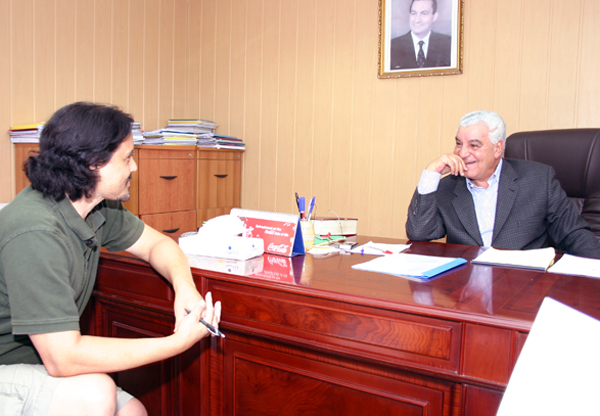
My 7th Interview with Dr. Hawass, conducted on 28 July
2008, took place again at his office at the Supreme Council of Antiquities
in Zamalek. We started out with some catching up:
Andrew: Hi Zahi. It seems like lots of exciting things
have been happening in Egypt since we last spoke. Tell me something new
and exciting.
Zahi: At Saqqara we have just found a pyramid of a queen, she was one of
the queenís of King Teti but we didnít announce this formally yet. We also
found other tombs that we havenít yet announced at Saqqara.
At the Valley of the Kings, we are excavating now, we found the entrances
of 2 tombs, KV 64 and KV 65 and in October we will start the excavation.
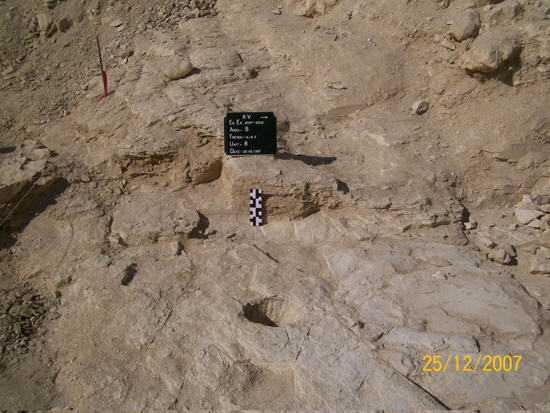
Andrew: Do you believe that one of these tombs belonged to Ramesses VIII?
Zahi: Yes, the one between Merneptah and Ramesses II could be the Tomb of
Ramesses VIII.
Andrew: What about the (undiscovered) Tomb of Amenhotep I?
Zahi: Amenhotep I should be at Deir El Bahri because they found evidence
there of the beginning of a temple, we believe that this tomb should be
located behind the temple. The temple was built after that. But in the
Valley of the Kings should be Queen Nefertiti, Thutmose II, Ramesses VIII
and all the queens of Dynasty 18, they were not buried in the Valley of
the Queens because the Valley of the Queens was started in Dynasty 19, and
therefore we are open to finding anything.
Andrew: Its very exciting what youíve done in the Valley of the Kings,
with the new improvements, it looks beautiful.
Zahi: You like the valley? We have these big changes everywhere.
There are also big things happening at the Unfinished Obelisk in
Aswan, Edfu, Kom Ombo. At Kom Ombo, when you arrive you see the temple from the
water, when you exit the temple now we have a museum opened just this week,
called the Crocodile Museum. This museum is telling the story about the
crocodiles. And we have (improvements at) Dendera. And at Saqqara you saw we
have these big changes, did you go to the museum? Did you see the cafeteria?
Behind we have storage for antiquities, big things.
We are restoring the Step Pyramid, the Serapeum, the South Tomb. Big things. At
Giza you saw the entrance? Now they have security, x-rays, clean bathrooms, we
are making these improvements all over Egypt.
Andrew: With the Step Pyramid
restoration, part of
the project is replacing mortar between the stones?
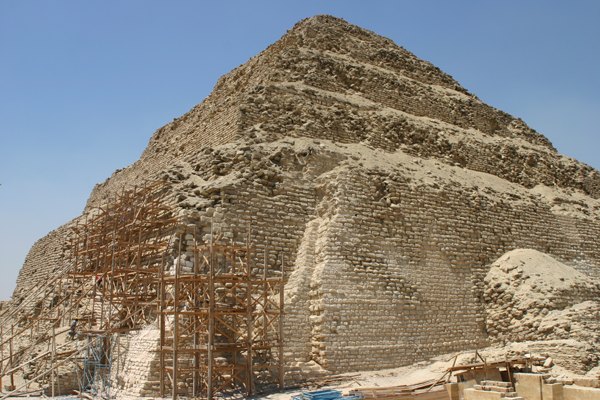
Restoration Project on the Step Pyramid at Saqqara
Zahi: Itís the first time that weíve had a big conservation project like this,
because all of these monuments were in critical condition for
years and years and no one really ever did anything, then for the first time we
are really a major important Egyptian conservation project for the Step Pyramid.
Andrew: In addition to the mortar, are you also building parts where it has
collapsed in the outside?
Zahi: A little, not really a big construction, but little work.
Andrew: The sand thatís accumulated on each level, are you going to leave that
there?
Zahi: Yes, weíll leave it.
Andrew: Youíre doing a
laser survey on the Step PyramidÖ
Zahi: The laser survey is very important. If you need to restore anything we
must first record all the stones. And all the stones cannot be recorded without
using the laser. The Japanese Team now are doing all the computation for each
stone then we can really know whatís weak, whatís strong, this is the only way
to restore the pyramid.
Andrew: When theyíre done with that survey, will they publish it, maybe through
a website?
Zahi: We are making our own website now for the Supreme Council of Antiquities,
and on this website weíll publish everything.
Andrew: Youíve made a lot of progress n a short time.
Zahi: We finished the National Museum of Rashid, this will be opened by the
president. Itís about the Marmeluke period. We opened the Museum in El Arish,
its opened to the public, itís a beautiful museum showing all these fascinating
things connected with the Sinai. We are working now to
open the National Museum in El-Swiss and this museum will show the history of
the people there from the pharaonic period until today. We are working now with
the Akhenaten Museum in Minya.
Andrew: Tell me more about that. We visited Amarna on this visit and traveled
through El Minya.
Zahi: The museum is in Minya, itís the capital by the water. In Amarna you saw
the changes, this big beautiful road. Visitors used to take hours until they
could arrive to visit, and youíve seen how the tombs are improved now, and
we are working on the Visitor Center, we are making this at the Nile. You saw a
big building, we are building it now. That is the Visitor Center that you will
go to first to introduce the site. When you enter Amarna from the Nile youíll go
through the Visitor Center. The Visitor Center will introduce Amarna, youíll
know whatís happening, youíll know what you are visiting.
And we are working now on the site management of Beni Hasan and Tuna El Gabal
and we are building this museum, we finished the construction of the Akhenaten
Museum, it is the museum that will tell the public about the history of
monotheism and its only about Akhenaten and the royal family of Amarna.
Andrew: Which pieces will be moved into that museum?
Zahi: Most of the Amarna pieces from here and from storages everywhere.
Andrew: Pieces from the Luxor Museum as well.
Zahi: Yes.
Andrew: Thatís very exciting.
Zahi: We are building now the
Grand Museum.
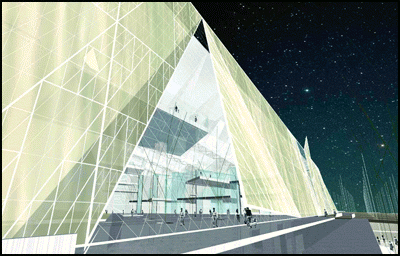
An Artist conception of the Grand Museum |

Statue of Ramesses at the Grand Museum |
Andrew: We saw that the giant statue of Ramesses from Ramesses Square had
already been moved there.
Zahi: Yes and we have finished the construction of the conservation rooms. The
big construction of the museum will start in October, its 5 years. All King
Tutís objects will be there, the 4,500, and most of the objects at the Cairo
Museum, and we are finishing, we finished the construction of the Civilization
Museum in Old Cairo, in Fustat. At the Cairo Museum now we are working on the
basement. We are making an Open Museum. On the east side of the museum we are
demolishing the wall making an iron wall that people can look at night and see
the objects in the garden. In eight months from now you will only enter the
museum from that entrance but you will exit from the west side to a Book Store
and a Cafeteria. And the museum will be about Egyptian Art and also talking
about the archeological background of each piece.
Andrew: Will the pieces be labeled with updated information cards?
Zahi: No, it will be the archaeological concepts, it will have graphics, like
for the statue of Khafre we can show the Valley Temple, how it was found,
photographs, graphics and things like this. This is how we can educate the
people about the archaeological concepts of each piece.
Andrew: What work has been done in Old Cairo?
Zahi:
On Al-Muizz Street in Old Cairo itís beautiful now, we stopped the cars. You should
walk this at night, its incredible. You can smell the history of the 1000 years
of Cairo. I made an interview for BBC Worldwide about my dream of Cairo, how can
people see Cairo. When people are walking the Al-Muizz Street you see beautiful
mosques, houses, you know beautiful things and we stopped the cars. At night it
is incredible.
Andrew: I'm happy to hear about those improvements.
Andrew: The solar boat, there was just exciting news about the camera that was
inserted in the pit of the second boat to allow it to be viewed in situ.
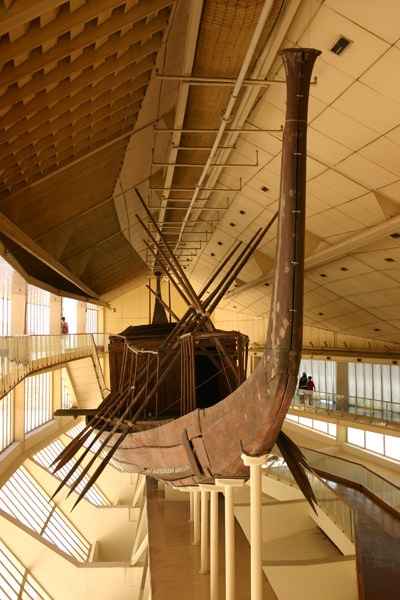
The First Solar Boat
Zahi: You know this boat was found in 1954. But since it was found the problem
was that in 1987 they opened a hole, the National Geographic came here to drill
that hole to see what it looked like in the sealed pit. When they drilled the
hole and inserted the camera they found there were insects and water in there.
Then I brought the Japanese in 1992, and the Japanese killed the insects and
built the museum above that pit. Now we have a project that consists of the
following:
1. We did put a camera in there with a TV screen and 8 seats where people can
pay 20 LE and they can see, for the first time, whatís underneath the pit, the
boat in situ;
2. We will start in this coming year, in a few months from now, the Japanese
team will take this boat and restore it, and reconstruct the boat;
3. The existing boat with this second one, we are building in the Grand Museum 2
Museums for the boats.
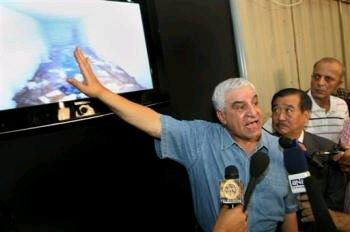
Dr. Hawass shows the screen that has been installed to
view the second Solar Boat in situ
Andrew: Fantastic!
Zahi: That really is a big important project that we are doing.
Andrew: Well, speaking of Giza, and I always ask you about this, the next step
in the exploration of the Queenís Chamber shafts. Iíve been following up on this
over the years. I know last time we spoke about it you were testing a new robot
and you had some failed tests. What is the present disposition of this? People
are always very interested and constantly ask me about this.
Zahi: I meet now with people from Singapore, and scientists from Manchester
University, and also from Hong Kong, and we built a kind of a tunnel in the
desert, similar to the one in the Great Pyramid, and they made 3 times
experiments. And next month we have the final experiment. After that, weíll
choose the team to continue the work.
Andrew: Do you have any timeframe as to when you will do the next exploration?
Zahi: We will hope that itís the beginning of next year, maximum.
Andrew: I have to ask you, I went into the Tomb of Seti I and saw what youíre
doing in there, protecting the walls and have dug so much of the tunnel in there
that youíve been clearing. Tell me, what are you finding?
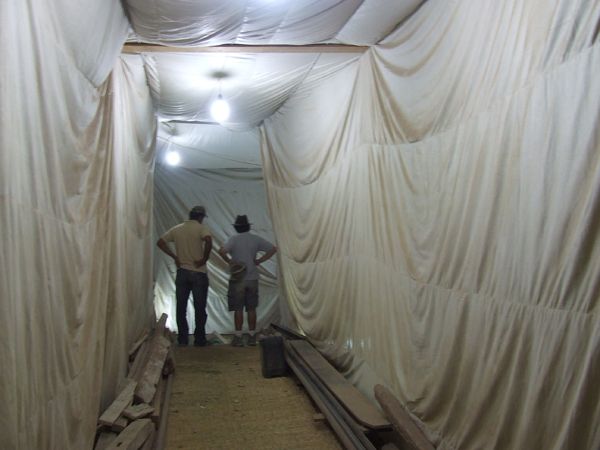
Protecting the walls near the excavation in KV 17, the
Tomb of Seti I
Zahi: We went into the tunnel for about 136.5 meters, and it is so exciting, it
is so dangerous. But suring our work we found shawabtis, made of faience and
made of wood, and we found inscribed rocks, one of them with the cartouche of
Seti I and we found pottery vessels dated to Seti I. The existence of these
artifacts within that tunnel can show the end of this tunnel could be the second
chamber of Seti. Because some people thought that the end of the tunnel should
be a lake, to be connected with Osiris, but it doesnít make any sense why this
tomb would be the only one that has these kind of things. That is why we hope
that by the end of this year will be a discovery that will make it into the
Valley of the Kings Book.
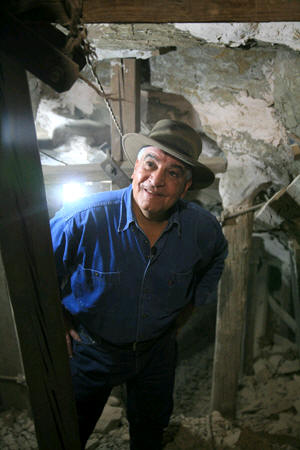
Dr. Hawass inside the tunnel in the tomb of Seti I
Andrew: The excavation season resumes in October?
Zahi: In October we will continue with these two tombs, KV 64 and KV 65, and we
found a tomb thatís coming from up down, and we found in the cliff a man made
wall, and the bottom area to be like the entrance of a tomb, and working in the
Tomb of Seti. This winter the Valley of the Kings will be so busy that no one
really can believe what will happen.
Andrew: You mention in the article about transferring King Tutankhamenís body to
a climate controlled case in his tomb that you were considering closing his tomb
for restoration. Is this still planned?
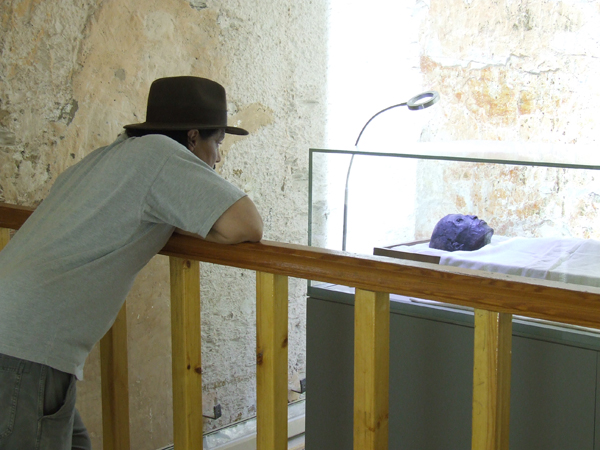
King Tutankhamen, now protected and on display in his
tomb
Zahi: I thought after that everyone was saying that the people would really be
disappointed and this is why I thought that we would only let a certain number
of people to enter everyday. We limited the number, and close the tomb now from
12:00 to 2:00. And I am having the tomb evaluated by the Getty Institute to find
out if the tomb is now stable or not. If not, I will close the tomb. If it is
stable, I will keep it open.
Andrew: Currently, the 3rd Pyramid of Menkaure is closed on the Giza Plateau. Whatís the next pyramid on the Giza plateau that will be closed for
cleaning in your rotation system?

Cleaned passageway
inside the closed Pyramid of Menkaure
Zahi: The 2nd Pyramid, the Pyramid of Khafre.
Andrew: When?
Zahi: We have not decided, but we will decide in a month.
Andrew: Originally you were going to rotate and close each pyramid, including
the Great Pyramid. Has this plan been changed?
Zahi: Khufu, since we limited the visitors to 300 per day, there is no problem.
Andrew: So there are no plans to close that again?
Zahi: I donít think that we need to because 300 visitors a day are not really
harming it.
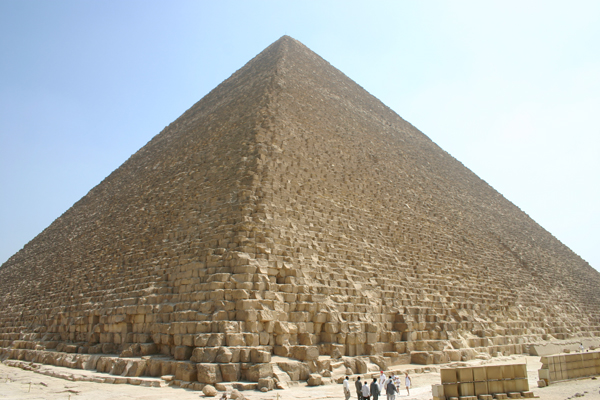
The Great Pyramid of Khufu
Andrew: Tell me about the results of the DNA testing on the 18th Dynasty
Mummies.
Zahi: We are doing that now, we will announce this in two months.
Andrew: Are you finding something exciting?
Zahi: We are, but we cannot talk about it yet.
Andrew: How about the Egyptian team?
Zahi: The Egyptian mummy team is only Egyptian. It consists of good
radiologists, good DNA people, experts with the database, and Egyptologists. Two
days ago we went to the Faculty of Medicine at Cairo University and we did a CT
scan for the first time on the
fetuses of King Tut, there are 2. The fetuses in
the Faculty of Medicine CT scanned them and we did take DNA, for the first time.
This happened yesterday.

Examining the 2 fetuses found inside Tutankhamen's Tomb
(Photo by: Mohammed Megahed)
Andrew: When do you expect youíll announce these results?
Zahi: In the beginning of November.
Andrew: Now, tell me about the
Zahi Hawass Prize.
Zahi: The Zahi Hawass is not really a prize, itís a scholarship by my name at
the American University at Cairo. And people are making donations through the
website directly to the University. Itís a tax deduction.
Andrew: I have an Anthropology student with me. Would you answer some of her
questions?
Zahi: Of course!
Whitney: My first question is about the mummy found in KV 55. There were new
studies on the bones found in KV 55?

Inside the enigmatic KV 55
Zahi: We did a CT scan and a DNA test of this, then we were not sure 100% if
this was the skeleton of Akhenaten. The coffin confirms its for Akhenaten. But
this doesnít mean because the skeleton was with the coffin that this could be
for Akhenaten. But we will be able through our studies to confirm all the
information about this.

The skeletal remains found in the sarcophagus in KV55
Whitney: I know that it used to be that the age of that skeleton was estimated
to be in its 20ís.
Zahi: The CT scan estimated over 30. We are not sure. The DNA will reveal all
the correct information.
Whitney: I was reading about the mummy caches and I was wondering about a mummy
that was found in the Deir El Bahri cache that was bound wrapped in sheep skin.
What do you think of this?

Zahi: Thatís called Man E. That is, in my opinion that this is the son of
Ramesses III. We know from history that he made a conspiracy with his mother
against his father. And I believe that a man who had a sheep skin means that
this was dirty. Thatís how the Egyptians imagined hell. He tried to kill his
father, he should go to hell. And we did a CT scan of that mummy and weíll see.
Weíll do the DNA later because we are still doing Dynasty 18 and this is Dynasty
19. I did finish almost all the identified and unidentified mummies of Dynasty
18.
Andrew: Have you opened the second DNA lab that youíve been speaking of yet?
Zahi: We are doing it now, this week, at the Faculty of Medicine.
Whitney: In King Tutís tomb I read on your website that an all Egyptian team
found undisturbed pots in one of the magazines?
Zahi: Yes, we have things still left by Howard Carter. IN the chapels for the
statues we found bowls, we found baskets, names of King Tut on the seals. All
these were left in the West Bank by Howard Carter and weíve moved them to the
Cairo Museum.
Whitney: Have you opened the pots yet?
Zahi: We will, we have not opened the pots yet.
Whitney: I have one last question. Who do you think was the pharaoh of the
Exodus?
Zahi: We do not know. We have no evidence, at all. Nothing in archaeology can
show this. We have only one thing at the Cairo Museum, the stela of Merneptah,
thatís it. But we donít know. There is one scene from a tomb of Dynasty 12 that
has a name Ibsha, people say it is Abraham, but we are not sure.
Andrew: Thank you so much Zahi, a pleasure as always. Iíll see you again soon.
Zahi. Thanks to you as well, Andrew. Have a safe trip.
|

















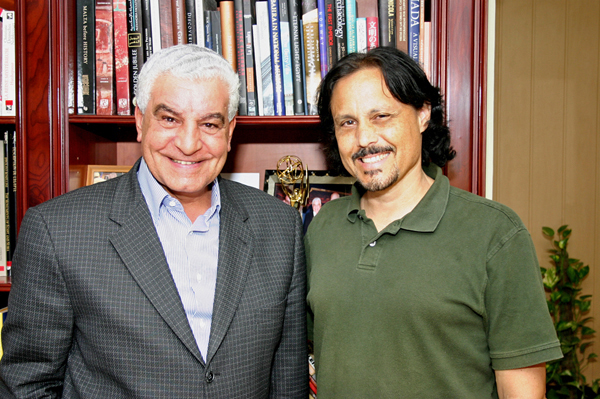
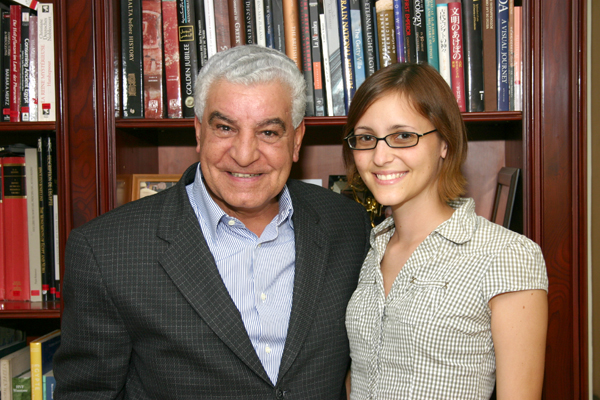
 RETURN
TO Guardian's Egypt Main Gate
RETURN
TO Guardian's Egypt Main Gate